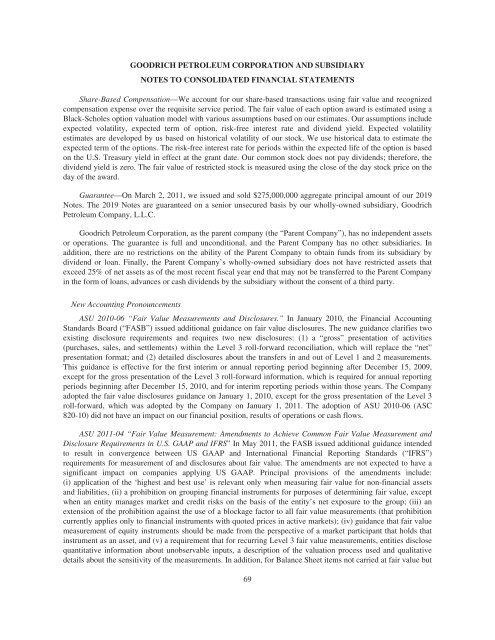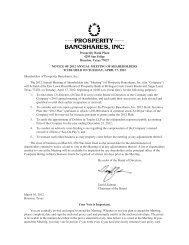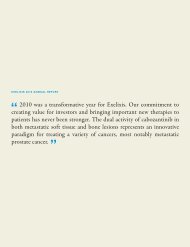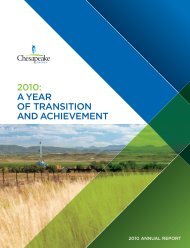goodrich petroleum corporation - RR DONNELLEY FINANCIAL
goodrich petroleum corporation - RR DONNELLEY FINANCIAL
goodrich petroleum corporation - RR DONNELLEY FINANCIAL
Create successful ePaper yourself
Turn your PDF publications into a flip-book with our unique Google optimized e-Paper software.
GOODRICH PETROLEUM CORPORATION AND SUBSIDIARY<br />
NOTES TO CONSOLIDATED <strong>FINANCIAL</strong> STATEMENTS<br />
Share-Based Compensation—We account for our share-based transactions using fair value and recognized<br />
compensation expense over the requisite service period. The fair value of each option award is estimated using a<br />
Black-Scholes option valuation model with various assumptions based on our estimates. Our assumptions include<br />
expected volatility, expected term of option, risk-free interest rate and dividend yield. Expected volatility<br />
estimates are developed by us based on historical volatility of our stock. We use historical data to estimate the<br />
expected term of the options. The risk-free interest rate for periods within the expected life of the option is based<br />
on the U.S. Treasury yield in effect at the grant date. Our common stock does not pay dividends; therefore, the<br />
dividend yield is zero. The fair value of restricted stock is measured using the close of the day stock price on the<br />
day of the award.<br />
Guarantee—On March 2, 2011, we issued and sold $275,000,000 aggregate principal amount of our 2019<br />
Notes. The 2019 Notes are guaranteed on a senior unsecured basis by our wholly-owned subsidiary, Goodrich<br />
Petroleum Company, L.L.C.<br />
Goodrich Petroleum Corporation, as the parent company (the “Parent Company”), has no independent assets<br />
or operations. The guarantee is full and unconditional, and the Parent Company has no other subsidiaries. In<br />
addition, there are no restrictions on the ability of the Parent Company to obtain funds from its subsidiary by<br />
dividend or loan. Finally, the Parent Company’s wholly-owned subsidiary does not have restricted assets that<br />
exceed 25% of net assets as of the most recent fiscal year end that may not be transferred to the Parent Company<br />
in the form of loans, advances or cash dividends by the subsidiary without the consent of a third party.<br />
New Accounting Pronouncements<br />
ASU 2010-06 “Fair Value Measurements and Disclosures.” In January 2010, the Financial Accounting<br />
Standards Board (“FASB”) issued additional guidance on fair value disclosures. The new guidance clarifies two<br />
existing disclosure requirements and requires two new disclosures: (1) a “gross” presentation of activities<br />
(purchases, sales, and settlements) within the Level 3 roll-forward reconciliation, which will replace the “net”<br />
presentation format; and (2) detailed disclosures about the transfers in and out of Level 1 and 2 measurements.<br />
This guidance is effective for the first interim or annual reporting period beginning after December 15, 2009,<br />
except for the gross presentation of the Level 3 roll-forward information, which is required for annual reporting<br />
periods beginning after December 15, 2010, and for interim reporting periods within those years. The Company<br />
adopted the fair value disclosures guidance on January 1, 2010, except for the gross presentation of the Level 3<br />
roll-forward, which was adopted by the Company on January 1, 2011. The adoption of ASU 2010-06 (ASC<br />
820-10) did not have an impact on our financial position, results of operations or cash flows.<br />
ASU 2011-04 “Fair Value Measurement: Amendments to Achieve Common Fair Value Measurement and<br />
Disclosure Requirements in U.S. GAAP and IFRS” In May 2011, the FASB issued additional guidance intended<br />
to result in convergence between US GAAP and International Financial Reporting Standards (“IFRS”)<br />
requirements for measurement of and disclosures about fair value. The amendments are not expected to have a<br />
significant impact on companies applying US GAAP. Principal provisions of the amendments include:<br />
(i) application of the ‘highest and best use’ is relevant only when measuring fair value for non-financial assets<br />
and liabilities, (ii) a prohibition on grouping financial instruments for purposes of determining fair value, except<br />
when an entity manages market and credit risks on the basis of the entity’s net exposure to the group; (iii) an<br />
extension of the prohibition against the use of a blockage factor to all fair value measurements (that prohibition<br />
currently applies only to financial instruments with quoted prices in active markets); (iv) guidance that fair value<br />
measurement of equity instruments should be made from the perspective of a market participant that holds that<br />
instrument as an asset, and (v) a requirement that for recurring Level 3 fair value measurements, entities disclose<br />
quantitative information about unobservable inputs, a description of the valuation process used and qualitative<br />
details about the sensitivity of the measurements. In addition, for Balance Sheet items not carried at fair value but<br />
69











